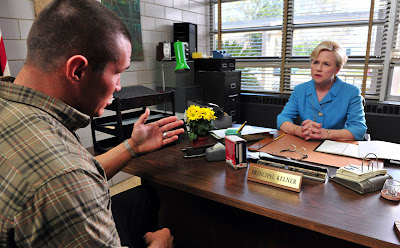If you, like TrustMovies, have long been a fan of the films of Dan Ireland -- The Whole Wide World, The Velocity of Gary, Passionada and Mrs. Palfrey at the Claremont -- you won't want to miss his newest addition (though most everyone else seems to have). Mr. Ireland is interested in odd relationships: the characters played by Zellweger and D'Onofrio in "World," D'Onofrio's with that of Thomas Jane in "Gary," Jason Isaacs' with a younger and older female in Passionada, and a young Rupert Friend's with an old Joan Plowright in "Mrs. Palfrey." In his latest endeavor, the focus is on his title character and her several relationships with different men -- and one woman.
Based on an E.L. Doctorow story (unread by me), JOLENE seems an unusual movie by the usual standards of this director (shown at left). Rather like a road movie, with the road being the main character's life as it unfurls in front of us, it's chock full of interesting incidents. (It's also a road movie in that, every so often, Jolene hits that road toward a new location and love.) As played by newcomer Jessica Chastain, our heroine begins as a glowing, 15-year-old bride in South Carolina (below, right, with her bow-tied groom, the sweet, sad Zeb Newman, at left, and his home-wrecking uncle, an excellent Dermot Mulroney, center).
For the first (but not the last) time, money and power conspire to trap our girl, who, as an underage ward of the state, is plopped into a reformatory where one of the guards (a very good Frances Fisher, below) takes a shine to her.
From there, it's off to Arizona where, as a car hop, Jolene meets a tattoo impresario and would-be musician (played by Rupert Friend, below).
When men prove once again unreliable, she's off to Vegas where, working as a pole dancer (Ms Chastain does one of the rare, sexy and actually interesting dances of this sort that film has yet given us), she meets hotshot Chazz Palminteri, below, whose mob ties make for high living. For awhile.
Then it's back to the south and and a job in Oklahoma, where she catches the eye of the heir (Michael Vartan, below) of one of the wealthiest families in town, and money and power conspire once again.
In each episode our girl is in the relatively passive position, preyed upon (sort of) by the more powerful male. And it is clear that she enjoys the attention and gives into it willingly. Yet, instead of making her seem stupid or coarse, thanks to Ireland's clear-eyed direction and to Ms Chastain's very impressive performance, it is obvious that Jolene is simply part of the dance of life that is constantly going on. She's a decent young woman making the best of her situation. The actress is not given any scenes of great depth that call for "amazing acting." Rather it's her believability, her always-grounded quality, along with a quiet charisma and porcelain-skinned beauty that hold us in thrall. Chastain is a keeper, and I can't wait to see more of her.
While the movie definitely has a soap-opera plot -- and some wonderfully rich, glossy locations, all of which make it a non-stop-enjoyable experience (my companion said it reminded him of some of the later Lana Turner movies) -- it is grounded by a seriousness of purpose that allows it to rise above the suds, seaminess, and surface delights. The film's final scene, a kind of epilogue to all that has gone before, brings this home in spades. It's intelligent, thoughtful and little bit mysterious -- just like its memorable heroine. By the end of it you'll know very well why you're in love with Jolene, and the movie about her.
Out this week on DVD, and available for sale or rental, Jolene can be found at the usual retailers.



















































